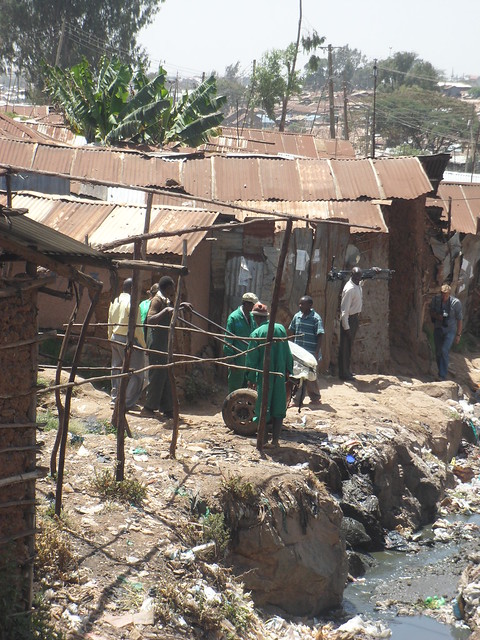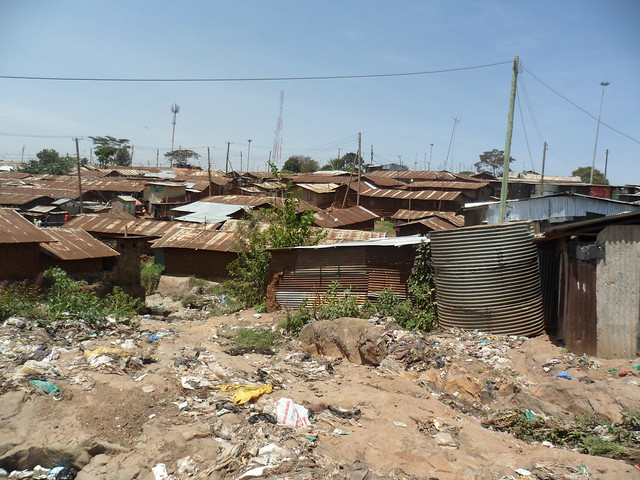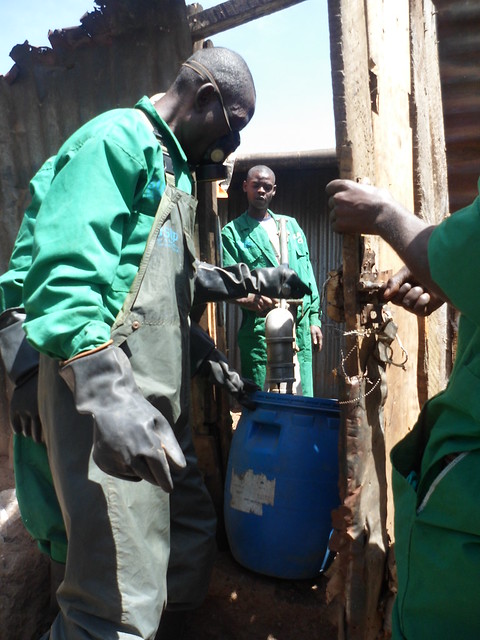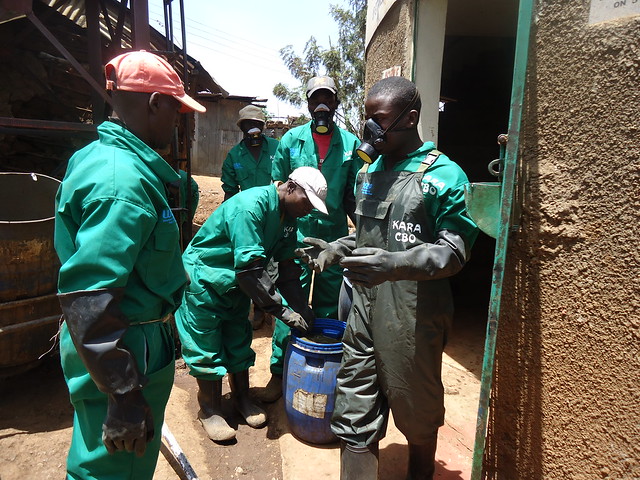- Equity, inclusion and sanitation workers
- Sanitation workers
- Health and safety aspects for sanitation workers
- Health guidelines and standards for pit emptiers and exhauster operators
Health guidelines and standards for pit emptiers and exhauster operators
58.8k views
- sman
-
Less
- Posts: 1
- Likes received: 0
- Susan
-
Less
- Posts: 2
- Likes received: 0
Re: Health guidelines and standards for pit emptiers and exhauster operators
Please Log in to join the conversation.
You need to login to replyRe: Protocols to protect workers and environment from biological hazards during pit emptying
Water Research Commission, 4 Daventry Road, Lynnwood Bridge Office Park, Bloukrans Building, Pretoria.
Postal Address:
Private Bag X03
GEZINA, 0031, South Africa
email: This email address is being protected from spambots. You need JavaScript enabled to view it.
mobile: +27 (0)60 502 1841
This message has attachments files.
Please log in or register to see it.
Please Log in to join the conversation.
You need to login to reply- Bobbie
-
Less
- Posts: 9
- Karma: 3
- Likes received: 6
Re: Protocols to protect workers and environment from biological hazards during pit emptying
We are currently involved with a Water Research Commission project in South Africa looking at what kinds of exposure (workers) and contamination (environment) happens during pit emptying and how we can minimise it. While proper tools and protective equipment need to be in place, there is a huge behavioural component. In the absence of clear and detailed protocols, workers are likely to handle both routine situations and accidents/incidents with a "public works" mentality rather than a "biohazard" mentality, not properly addressing the risk of exposing themselves to pathogens or contaminating the household environment where they work, thereby introducing an ongoing risk of householders being exposed to pathogens left behind after pit emptying.
I have been gathering recommendations, regulations, guidelines and protocols for safe work practices with regard to biological hazards from various sources in different countries. Following FSM2, others who are interested in developing health and safety plans for workers have come together to develop a framework to guide safe handling of sludge. If you have guidelines you would be willing to share or if you would be interested in contributing to the framework we are developing, your input would be valued.
Regards
Bobbie Louton
Partners in Development
South Africa
This email address is being protected from spambots. You need JavaScript enabled to view it.
Please Log in to join the conversation.
You need to login to replyRe: Health guidelines and standards for pit emptiers and exhauster operators
In addition to the post I made above regarding the use of the Gulper, please have a look at the video below showing the testing of the second prototype pump in February 2011 in Kibera
Here is the link:
Below is a picture that I took of the Gulper in Kibera March 2012.
All pictures and a short video can be found in the SuSanA flickr account here: www.flickr.com/photos/gtzecosan/sets/72157629487403117/
Below is also a video of pit emptying in Mozambique provided by WSUP UK.
Best regards
Doreen
GIZ Sustainable Sanitation Programme
Policy Advisor in Bonn, Germany
Deutsche Gesellschaft für Internationale Zusammenarbeit (GIZ) GmbH
E This email address is being protected from spambots. You need JavaScript enabled to view it.
Attachments:
-
3.JPG (Filesize: 43KB)
Please Log in to join the conversation.
You need to login to replyRe: Health guidelines and standards for pit emptiers and exhauster operators
Thank you for your comments and for introducing the second part of this section which consists of mechanical emptying by use of a Gulper. In particular thanks to Hajo and Georges for their insightful contribution and discussion regarding manual pit emptiers.
Today I had the opportunity to speak to Njoroge, the chairman of Kara Group who use the Gulper. I asked him the questions that Elisabeth asked (see below)
Questions
1.The personal protective equipment worn by the workers in the photos looks still very new and not very well used - how long have they had this equipment for and how many emptying jobs do they do per day with this equipment?
2.On the photos you see many people around the pit emptying. Was that just for demo purposes? How many people are usually involved in one job? More than 2?
3.Is it more or less expensive for me (as a client, i.e. pit latrine owner) to hire this CBO with their gulper compared to the unlucky chaps which do the manual pit emptying (scrol up to see photos of them in one of Doreen's earlier postings)?
4.As a pit latrine owner, what incentive do I have to rather ring up that CBO compared to manual pit emptying? Is it faster? Less odourous?
5.I liked that little video which you posted. But how about solid waste, doesn't it block the gulper? Can it empty the pit completely or only the top, watery part until the more solidified layer starts? - Link to the short video clip: www.flickr.com/photos/gtzecosan/67970945...et-72157629487403117
Answers
1. They have had the protective clothing and equipment since September 2011 and they wash teh clothes 3 times a week. They only have one pair. The protective clothing were sourced from Safetytech Nairobi and are of high quality. Safetytech is a company that supplies occupational safety personal protective equipment here in Kenya.
2.On the photos there were many people from the group. This is because before they demonstrated to us how the Gulper works, we had a brief meeting with them and Umande Trust, the NGO that assists them with their finance and monitors that they wear their personal equipment on a regular basis. That is why you are seeing quite a number of them in the pictures. When carrying out a job, only 3 -4 people are normally present.
3. It is more expensive to hire them than to hire a manual pit emptier. One drum costs about 600-700 Kenya shillings (5.60-6.50 Euros)when using a Gulper. A pit latrine could require about 3 drums thus costing 2100 Kenya shillings to empty (19.50 Euros).
It is much cheaper than an exhauster but more expensive than a manual pit emptier. Njoroge told me that it is the manual pit emptiers who spoil their market because they offer their services cheaply and don’t do a very good job e.g. don’t empty the toilet completely and a lot of spillages occur. Manual emptiers in Kibera get about 200- 300 shillings (2.79 Euros) per drum.
4.The incentive that a pit latrine owner has to hire Kara, the group that uses the Gulper is that it is cleaner, faster and there are less spillages that occur in comparison to the manual pit emptiers. With a gulper, one can empty 20 litres per 40 seconds. In addition, the job is more thorough than a manual pit emptier.
5.Regarding the solid waste, this is usually tackled in the initial stages. Normally the faecal sludge in the pit latrine is quite thick. Therefore they first add water and stir the sludge with a stick that has nails protruding. During the stirring the solid waste such as old clothes and sanitary towel get caught on the stick and that is how most of it comes out.
Now initially when they began, they had no problems as they had a designated manhole that they could use close by to dump the sludge into the river. However the landlady brought a lot of problems saying that she does not want them to dump sludge from external pit latrines in her compound. During the time that I visited, they went directly to the river and dumped the sludge there. However this has not always been the case. Nairobi Water & Sewerage Company had designated a manhole for them to dump the sludge.
At the moment they are frustrated and continue to dump in the river but this is because they have no other choice.

Njoroge told me today however that they have identified another manhole close by that they would like to use. However it is blocked by solid waste and is inaccessible. They would like to contact Nairobi Water & Sewerage Company to find out whether they could be allowed to dump the sludge there. They also want Nairobi City Council to come and clear the waste that has blocked the manhole. However even if Nairobi City Council do not clear the waste, they would be happy to clear it out themselves. Until the problem is solved, they have no choice but to dump in the river.
My thoughts are that even if they get another manhole, they might face the same problem from the neighbours. This is because all the houses in Kibera are very close to each other.

To sum it all up some advantages and disadvantages of a Gulper from my point of view
Advantages
- Creates jobs
- Provides services in areas that cannot be accessed by exhausters
- The Gulper can be repaired with locally available materials
- Low operation costs
Disadvantages
- If the distance to a discharge point is large, the workers tend to dump in nearby streams creating further health hazard
- Spillages can happen during pumping and transportation
- Problems with the location of the manhole especially in densely populated areas
Best regards
Doreen
GIZ Sustainable Sanitation Programme
Policy Advisor in Bonn, Germany
Deutsche Gesellschaft für Internationale Zusammenarbeit (GIZ) GmbH
E This email address is being protected from spambots. You need JavaScript enabled to view it.
Please Log in to join the conversation.
You need to login to reply- Elisabeth
-
- User is blocked
- Freelance consultant since 2012
Less- Posts: 3372
- Karma: 54
- Likes received: 932
Re: Health guidelines and standards for pit emptiers and exhauster operators
Thank you all for this in-depth discussion and very insightful comments. In particular thanks to Hajo and Georges for making their first postings on this forum here under this topic! Very interesting discussion.
By the way Georges wrote a detailed report about the situation in Sierra Leone which is accessible here:
www.susana.org/lang-en/library?view=ccbktypeitem&type=2&id=1525
Mikhael, G. (2011). Sanitation market assessment, Freetown, Sierra Leone - VOLUME II: Assessment of faecal sludge emptying services.
It was the pictures in Annex B that really shocked me and are still very much sticking in my head.
I lean also towards Hajo's opinion of "why bother trying to improve something that is flawed from the start (i.e. pit latrines in dense urban areas)". Or simplistically put, a pit latrine can be very fine in a rural area where there is no need to empty it. But when the situation demands pit emptying (e.g. lack of space to build new ones), then you are in trouble... or even: "then you are in deep shit" (pardon the pun, couldn't resist).
On the other hand, it is also not fair to ignore the existing situation and the plight of those risking their lives in the process of emptying pit latrines. And maybe the whole faecal sludge management side will just be a stepping stone into a different direction (i.e. when we realise that carting a lot of water in vacuum tankers for many kilometres through already congested African cities (example Kampala) does not make so much economical sense).
So let me come back to some basic practical questions, based on the great photos and stories which Doreen has shared with us via her photos on flickr.
She has put up photos of workers of a CBO which are using the "Gulper" to empty pit latrines. Here you see some example photos (more on the link below):

SAM_2223 by Sustainable sanitation , on Flickr

Appropriate nosemasks,occupational overalls and dungarees for the job by Sustainable sanitation , on Flickr

Conflic regarding the position of the manhole by Sustainable sanitation , on Flickr
My simple questions to Doreen (and to WSUP? Doreen, can you encourage WSUP to reply here?) are:
- The personal protective equipment worn by the workers in the photos looks still very new and not very well used - how long have they had this equipment for and how many emptying jobs do they do per day with this equipment?
- On the photos you see many people around the pit emptying. Was that just for demo purposes? How many people are usually involved in one job? More than 2?
- Is it more or less expensive for me (as a client, i.e. pit latrine owner) to hire this CBO with their gulper compared to the unlucky chaps which do the manual pit emptying (scrol up to see photos of them in one of Doreen's earlier postings)?
- As a pit latrine owner, what incentive do I have to rather ring up that CBO compared to manual pit emptying? Is it faster? Less odourous?
- I liked that little video which you posted. But how about solid waste, doesn't it block the gulper? Can it empty the pit completely or only the top, watery part until the more solidified layer starts? - Link to the short video clip:
www.flickr.com/photos/gtzecosan/67970945...et-72157629487403117
At the end of the day, also this faecal sludge is dumped in the river (actually a manhole - connected to a sewer I assume - was meant to be used but the residents close to the manhole object to this).
This is the set description by Doreen that goes with these photos:
Regards,The pictures were taken in Gatwekera, Kibera Tosha Bio Centre and show a group of workers using a Gulper.
A gulper is a low cost effective solution for sludge emptying. The pump works similar to a water pump. The bottom of the pipe is lowered to a pit latrine or a septic tank. The operator remains at the surface and pumps the sludge out. After the work has been done, the gulper is taken apart and should be cleaned appropriately. Hands should be protected when cleaning.
The emptiers are from Kara Group CBO in Nairobi, now a registered pit emptier company. The men were initially manual pit emptiers working independently in slums. They were then supported by WSUP to establish their business. The Gulper and protective clothing was initially given to them to start their business by Water and Sanitation for the urban poor (WSUP) <a href="www.wsup.com/index.htm" rel="nofollow">www.wsup.com/index.htm
The protective clothing were sourced from Safetytech Nairobi. Safetytech is a company that supplied occupational safety personal protective equipment.
They are responsible for cleaning the Gulper and their protective equipment. The nose masks fits very well and inhibits inhalation of any pathogenic particles and minimises the inhalation of toxic fumes.
They empty the containers in a drum which is in a cart and transport to a central emptying point. Pumping rate is 20 litres per 40 seconds.
Elisabeth
Freelance consultant on environmental and climate projects
Please Log in to join the conversation.
You need to login to reply- christian.rieck
-

- Moderator
Less- Posts: 118
- Karma: 7
- Likes received: 41
Re: Health guidelines and standards for pit emptiers and exhauster operators
my colleague Rahul has shared this tragic video on manual scavengers in India. It illustrates the dire need for enforced standards and sufficient payment of emptiers in order to protect their lifes .indiaunheard.videovolunteers.org/jai/lives-wasted-in-gutters/
Best regards,
Christian
Enhanced Water Security and Sanitation (ENWASS)
Sanitation for Millions
This email address is being protected from spambots. You need JavaScript enabled to view it.
Please Log in to join the conversation.
You need to login to reply- gsmikhael
-
- Georges MIkhael
Less- Posts: 11
- Likes received: 7
Re: Health guidelines and standards for pit emptiers and exhauster operators
In general Doreen I think your work on coming up with health guidelines for pit emptiers is quite useful for the sector and potentially for those emptying pit latrines.
Your recommendation of formalising and legalising the emptiers is, I think, very important. However, I don't think it is a silver bullet that will make all the problems fade away as you suggest (at least not in the places I've worked in). It is but one tool that can be employed - where the need exists - to help improve the sludge management practices of pit emptiers. In some cases, providing them with better emptying equipment might be enough. A well-managed, nearby transfer station might make it even better. Connecting them to the fertiliser market to sell the sludge might help too.
You use the example of water kiosks as a successful legalisation intervention for lowering cost and improving service quality compared to previous opportunistic water vendors. I'm not familiar with the exact case you are discussing, but based on similar cases I've had first hand experience with I would guess that legalisation was not the only reason why costs went down. The utility actually building a kiosk within the community (i.e. increasing local safe supply) could have pushed prices down. Was it possible that a tariff was also set? I guess the question to ask is, had the water cartels been legalised on paper and everything else stayed as is, would the prices have gone down? Based on my experience the answer is mostly likely not.
I can understand Trevor's questions on cost and how the recommendations you are making - as a whole - can be quite difficult and expensive to implement. Even if the full guidelines are adopted as law, it will take some time to for things to change on the ground and so you probably won't wake up tomorrow morning with a huge "health and safety" bill to pay. I feel that it is within that context of incremental improvements that these guidelines should be considered by practitioners.
With that being said, it is important that these improvements not become a burden on those we are trying to help. In my opinion (not everyone will agree), an extreme case of trying to improve working conditions but rather harming those we are trying to help is in Accra, Ghana. As I understand it, with the help of an international NGO, bucket latrines were outlawed (and enforced) because of the horrible conditions the bucket handlers were working in. Rather than taking away these workers' source of living, we could have built on their management skills and found ways to improve their working conditions. One example of this is the Uniloo work WSUP is currently doing in, ironically, Ghana.
Good luck with your work and looking forward to reading your final report.
Georges
Please Log in to join the conversation.
You need to login to reply- gsmikhael
-
- Georges MIkhael
Less- Posts: 11
- Likes received: 7
Re: Health guidelines and standards for pit emptiers and exhauster operators
I'll write a bit more later on regarding the general discussion that was happening earlier but I'd just like to reply to Hajo very briefly.
We do have a task of improving the sanitation situation for billions, but I don't think that in the process we can sidestep the health of the thousands providing emptying services. I agree, guidelines are difficult to enforce but setting a target/standard which we can all work towards helps us incrementally improve a situation. We have to start somewhere. I can't see why there would be a conflict between improving the working conditions of emptiers and improving sanitation for the general public. Nor a conflict between improving the working conditions of the emptiers and improving their practices.
I also don't generally agree with the idea that improving working conditions is equivalent to higher cost of services, or that people aren't willing to pay more for a better service. I believe there is potential for emptying technologies such as the sludge gulper or diaphragm pump that can provide a faster service than the traditional bucket-emptying method, which means more pits emptied per day and lower profit margins per pit to help compete with existing practices. I would guess that Doreen can expand on this based on her study of what WSUP is doing in Kibera with the sludge gulper.
As for the management of the services, I don't think we can paint all cities with the same brush of 90% on-site and 10% off-site. I don't think the solution to sanitation services, be it on or off-site, is either public management only or private management only. I believe the best approach is understanding the existing situation and working on incremental improvements. If there is a thriving private sector and a weak public sector, I'm not sure we can justify transferring the management of services from private to public.
Apologies if I misunderstood or wrongly characterised what you were trying to say. It is getting a bit late here!
Georges
Please Log in to join the conversation.
You need to login to reply- hajo
-

- retired in Germany... but still interested in water and sanitation... especially in OSS... and especially in Africa...
Less- Posts: 288
- Karma: 15
- Likes received: 156
Re: Health guidelines and standards for pit emptiers and exhauster operators
while I hope this will not evolve into a discussion only between you an me;
I believe that trying to do the wrong things in a right way does not yield sustainable solutions and is a waste of resources.
Pit latrines being build in high water tables, flooded areas, congested high density urban areas and with no permanent cover (to make them accessible) are all wrong applications. Tanzanian, WHO and UNICEF standards define an ‘improved’ pit latrine as one which has a concrete cover to ensure permanent separation of humans from shit. Developing ‘health guidelines and standards for pit emptiers’ is counteracting officially accepted standards that people must be separated permanently from shit, is trying to put rules to wrong practices.
Besides that, guidelines and standards hardly work and you will develop health guidelines and standards which few will adhere to and few are interested in – except the consultant having worked them out. Because few want to pay more for having their pit emptied ‘according to health standards’.
Therefore instead of trying to do the wrong things right, we should rather put all our efforts and resources into trying to convince Governments, administrations, financiers, development agencies, consultants, politicians and the general public to accept the following:
1. centralised piped sewers are a sustainable solutions to only 10% urban population in high income, (moderately) dense central areas in the foreseeable future;
2. the other 90% must be served with appropriate, sustainable on-site solutions such as septic tanks, double pit systems, de-hydrating single or dbl. vault systems, (dbl)VIP where appropriate;
3. also on-site systems require service chains for the collection, transport, treatment and disposal or reuse of toilet outputs as central piped systems do;
4. and because all infrastructure for centralised systems are provided by public funds also service chains of on-site systems should be provided from there;
5. And in order to make those service chains sustainable, enough numbers of customers are required for which financing mechanisms like revolving fund and micro-credit have to be provided so that many people can afford the household latrines which connect to these service chains.
Let us do the 'right' thing 'right', so far it has been done wrongly saying construction and emptying of HH are ‘private businesses’. Why should on-site system service chains be provided privately if all central sewers are public? Since 90% of the population will rely on on-site systems it is in the public interest for health and hygiene that they function sustainable.
kind regards
hajo
Albert Einstein
Any intelligent fool can make things bigger and more complex... It takes a touch of a genius - and a lot of courage to move in the opposite direction.
E.F. Schumacher
Everything should be made as simple as possible, but not simpler.
Albert Einstein
Please Log in to join the conversation.
You need to login to replyRe: Health guidelines and standards for pit emptiers and exhauster operators
I completely concur with you and Sjoerd that the solutions to these predicaments should encompass up scaling of sanitation facilities such as urine diversion dry toilets. Infact I do mention it in my report thanks to Sjoerd, but I disagree with you when you say that the discussion should not be on how to protect the manual pit emptiers.
As much as we would like to completely move away from simple pit latrines and VIPs, we have to acknowledge that they still exist and emptying of these pit latrines is a vital and crucial challenge when addressing the issue of faecal sludge management especially in low income densely populated urban areas. It is of course very welcoming news when you hear or read of up scaling of sanitation facilities constituting of dry separating toilets implemented in low income urban areas in developing countries. What happens to areas that will not benefit from up scaling of sanitation facilities? What happens between now and then? What about the existing sanitation facilities? How are we to mitigate the health risks of existing manual and mechanical pit emptiers if we do not acknowledge their existence? Unfortunately, simple pit latrines and VIPs are still going to be in existence for the next couple of years in urban and rural areas of developing countries due to the huge challenges we have in implementing sustainable sanitation facilities in low income areas.
Some figures from my country Kenya, according to the population and housing census done in Kenya in 2009, about 6.1 million households use simple pit latrines. This constitutes of about 2.1 million households in urban areas and 4.0 million households in rural areas. In addition, it is estimated that 431,000 households in Kenya use VIPs.
You even say it yourself, It is not possible to implement these facilities (dry separating toilets) at short notice. Therefore what do we with all the VIPs and simple pit latrines that are currently scattered everywhere? Obviously as long as the people are not able to upgrade to a more sustainable solution due to reasons and factors that we are all aware of, there is still the requirement to empty simple pit latrines and VIPs with the help of manual and or mechanical pit emptiers.
For that reason, I insist that there should be realistic vigorous measures promulgated and implemented in countries such as Kenya and Tanzania that still have a substantial amount of pit latrines and VIPs to ensure that appropriate health guidelines are in place for the manual pit emptiers. If we in the sanitation sector are serious about tackling these issues systematically, improving living conditions and ensuring that the people involved still maintain their dignity, then practical sustainable measures need to put in place to protect those involved in desludging latrines, be it simple or VIPs.
That is why I propose that this can be done either by linking them to the water utilities or promoting them to work as service providers within the private sector. In addition, it should be seen as a job opportunity for many youths in slum areas. It should be approached as a business through sanitation marketing and public awareness and should be appropriately institutionalised so as to ascertain dignity and decorum in the sanitation sector.
I look forward to your thoughts on the above.
Best regards
Doreen
GIZ Sustainable Sanitation Programme
Policy Advisor in Bonn, Germany
Deutsche Gesellschaft für Internationale Zusammenarbeit (GIZ) GmbH
E This email address is being protected from spambots. You need JavaScript enabled to view it.
Please Log in to join the conversation.
You need to login to reply- Equity, inclusion and sanitation workers
- Sanitation workers
- Health and safety aspects for sanitation workers
- Health guidelines and standards for pit emptiers and exhauster operators








